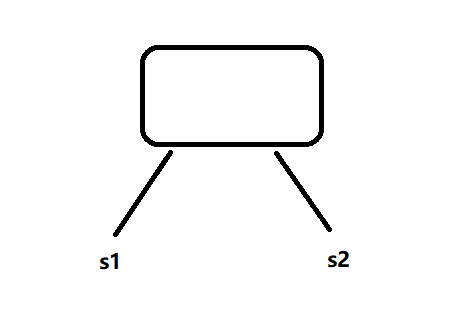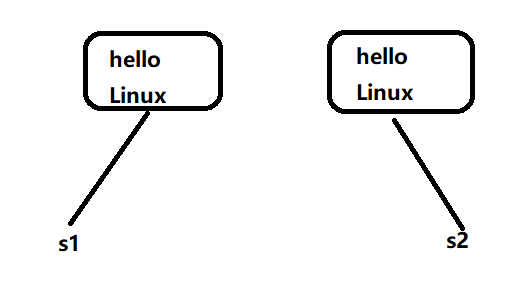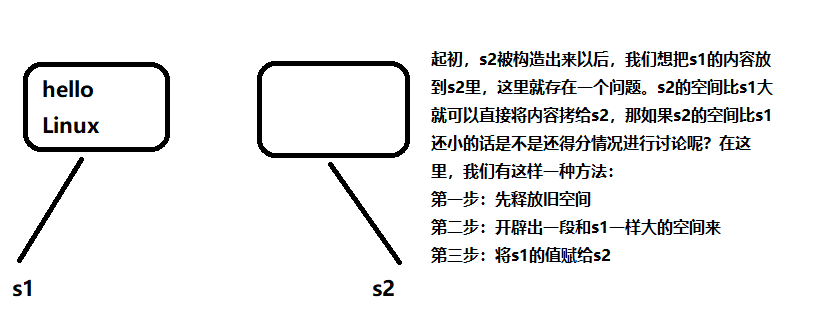C++ 中的深拷贝与浅拷贝
浅拷贝:又称值拷贝,将源对象的值拷贝到目标对象中去,本质上来说源对象和目标对象共用一份实体,只是所引用的变量名不同,地址其实还是相同的。举个简单的例子,你的小名叫西西,大名叫冬冬,当别人叫你西西或者冬冬的时候你都会答应,这两个名字虽然不相同,但是都指的是你。
假设有一个String类,String s1;String s2(s1);在进行拷贝构造的时候将对象s1里的值全部拷贝到对象s2里。
我们现在来简单的实现一下这个类
1 #include <iostream> 2 #include<cstring> 3 4 using namespace std; 5 6 class STRING 7 { 8 public: 9 STRING( const char* s = "" ) :_str( new char[strlen(s)+1] ) 10 11 { 12 strcpy_s( _str, strlen(s)+1, s ); 13 } 14 STRING( const STRING& s ) 15 { 16 _str = s._str; 17 } 18 STRING& operator=(const STRING& s) 19 { 20 if (this != &s) 21 { 22 this->_str = s._str; 23 } 24 return *this; 25 } 26 27 ~STRING() 28 { 29 cout << "~STRING" << endl; 30 if (_str) 31 { 32 delete[] _str; 33 _str = NULL; 34 } 35 } 36 37 void show() 38 { 39 cout << _str << endl; 40 } 41 private: 42 char* _str; 43 }; 44 45 int main() 46 { 47 STRING s1("hello linux"); 48 STRING s2(s1); 49 s2.show(); 50 51 return 0; 52 }
其实这个程序是存在问题的,什么问题呢?我们想一下,创建s2的时候程序必然会去调用拷贝构造函数,这时候拷贝构造仅仅只是完成了值拷贝,导致两个指针指向了同一块内存区域。随着程序的运行结束,又去调用析构函数,先是s2去调用析构函数,释放了它指向的内存区域,接着s1又去调用析构函数,这时候析构函数企图释放一块已经被释放的内存区域,程序将会崩溃。s1和s2的关系就是这样的:

进行调试程序发现s1和s2确实指向了同一块区域:

所以程序会崩溃是应该的,那么这个问题应该怎么去解决呢?这就引出了深拷贝。
深拷贝,拷贝的时候先开辟出和源对象大小一样的空间,然后将源对象里的内容拷贝到目标对象中去,这样两个指针就指向了不同的内存位置。并且里面的内容是一样的,这样不但达到了我们想要的目的,还不会出现问题,两个指针先后去调用析构函数,分别释放自己所指向的位置。即为每次增加一个指针,便申请一块新的内存,并让这个指针指向新的内存,深拷贝情况下,不会出现重复释放同一块内存的错误。
深拷贝实际上是这样的:

深拷贝的拷贝构造函数和赋值运算符的重载传统实现:
1 STRING( const STRING& s ) 2 { 3 //_str = s._str; 4 _str = new char[strlen(s._str) + 1]; 5 strcpy_s( _str, strlen(s._str) + 1, s._str ); 6 } 7 STRING& operator=(const STRING& s) 8 { 9 if (this != &s) 10 { 11 //this->_str = s._str; 12 delete[] _str; 13 this->_str = new char[strlen(s._str) + 1]; 14 strcpy_s(this->_str, strlen(s._str) + 1, s._str); 15 } 16 return *this; 17 }
这里的拷贝构造函数我们很容易理解,先开辟出和源对象一样大的内存区域,然后将需要拷贝的数据复制到目标拷贝对象,
那么这里的赋值运算符的重载是怎么样做的呢?

这种方法解决了我们的指针悬挂问题,通过不断的开空间让不同的指针指向不同的内存,以防止同一块内存被释放两次的问题,还有一种深拷贝的现代写法:
1 STRING( const STRING& s ):_str(NULL) 2 { 3 STRING tmp(s._str);// 调用了构造函数,完成了空间的开辟以及值的拷贝 4 swap(this->_str, tmp._str); //交换tmp和目标拷贝对象所指向的内容 5 } 6 7 STRING& operator=(const STRING& s) 8 { 9 if ( this != &s )//不让自己给自己赋值 10 { 11 STRING tmp(s._str);//调用构造函数完成空间的开辟以及赋值工作 12 swap(this->_str, tmp._str);//交换tmp和目标拷贝对象所指向的内容 13 } 14 return *this; 15 }
先来分析一下拷贝构造是怎么实现的:

拷贝构造调用完成之后,会接着去调用析构函数来销毁局部对象tmp,按照这种思路,不难可以想到s2的值一定和拷贝构造里的tmp的值一样,指向同一块内存区域,通过调试可以看出来:
在拷贝构造函数里的tmp:

调用完拷贝构造后的s2:(此时tmp被析构)

可以看到s2的地址值和拷贝构造里的tmp的地址值是一样
关于赋值运算符的重载还可以这样来写:
STRING& operator=(STRING s)
{
swap(_str, s._str);
return *this;
}
1 #include <iostream> 2 #include<cstring> 3 4 using namespace std; 5 6 class STRING 7 { 8 public: 9 STRING( const char* s = "" ) :_str( new char[strlen(s)+1] ) 10 11 { 12 strcpy_s( _str, strlen(s)+1, s ); 13 } 14 //STRING( const STRING& s ) 15 //{ 16 // //_str = s._str; //浅拷贝的写法 17 // cout << "拷贝构造函数" << endl; 18 // _str = new char[strlen(s._str) + 1]; 19 // strcpy_s( _str, strlen(s._str) + 1, s._str ); 20 //} 21 //STRING& operator=(const STRING& s) 22 //{ 23 // cout << "运算符重载" << endl; 24 // if (this != &s) 25 // { 26 // //this->_str = s._str; //浅拷贝的写法 27 // delete[] _str; 28 // this->_str = new char[strlen(s._str) + 1]; 29 // strcpy_s(this->_str, strlen(s._str) + 1, s._str); 30 // } 31 // return *this; 32 //} 33 34 STRING( const STRING& s ):_str(NULL) 35 { 36 STRING tmp(s._str);// 调用了构造函数,完成了空间的开辟以及值的拷贝 37 swap(this->_str, tmp._str); //交换tmp和目标拷贝对象所指向的内容 38 } 39 40 STRING& operator=(const STRING& s) 41 { 42 if ( this != &s )//不让自己给自己赋值 43 { 44 STRING tmp(s._str);//调用构造函数完成空间的开辟以及赋值工作 45 swap(this->_str, tmp._str);//交换tmp和目标拷贝对象所指向的内容 46 } 47 return *this; 48 } 49 50 ~STRING() 51 { 52 cout << "~STRING" << endl; 53 if (_str) 54 { 55 delete[] _str; 56 _str = NULL; 57 } 58 } 59 60 void show() 61 { 62 cout << _str << endl; 63 } 64 private: 65 char* _str; 66 }; 67 68 int main() 69 { 70 //STRING s1("hello linux"); 71 //STRING s2(s1); 72 //STRING s2 = s1; 73 //s2.show(); 74 const char* str = "hello linux!"; 75 STRING s1(str); 76 STRING s2; 77 s2 = s1; 78 s1.show(); 79 s2.show(); 80 81 return 0; 82 }
参考与
浅析C++中的深浅拷贝 - qq_39344902的博客 - CSDN博客
https://blog.csdn.net/qq_39344902/article/details/79798297



